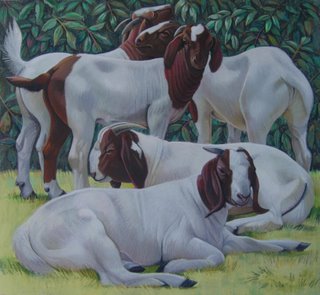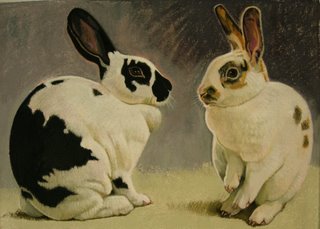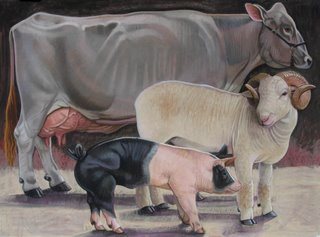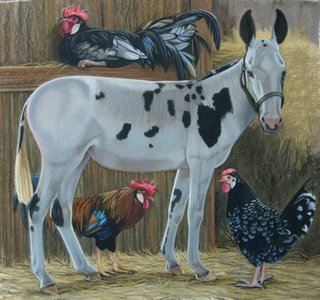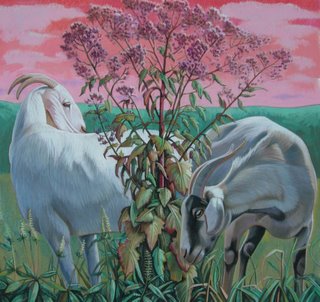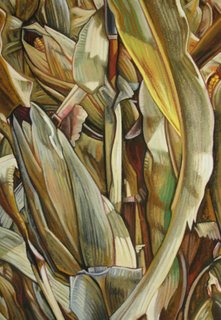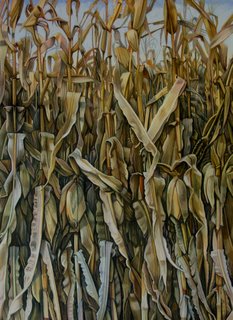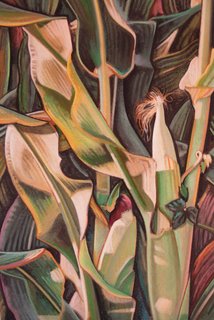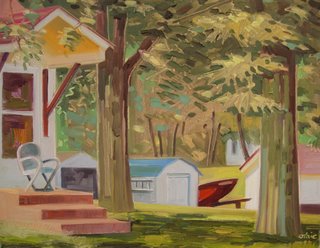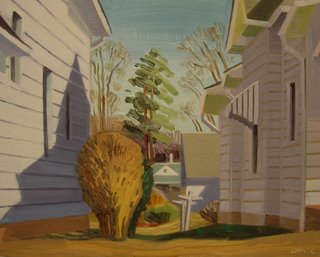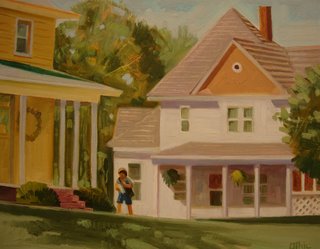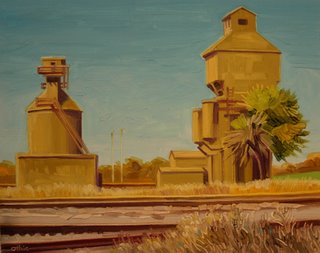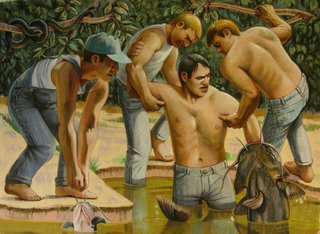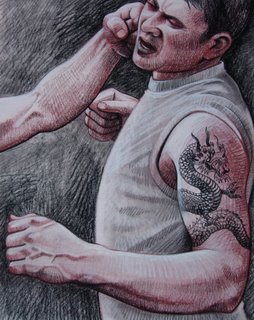Nora Othic-hard work (Art Talk series)
Five Bohr Goats
Pastel by Nora Othic
Pastel by Nora Othic
Conversation
Pastel by Nora Othic
Pastel by Nora Othic
Cow, ram, pig
Pastel by Nora Othic
Pastel by Nora Othic
To visit Othic's country studio click on triangle above. 5 minute video.
Othic: You know at the State Fair how they clean and polish all the animals within an inch of their life. They are really in superb condition. This donkey was just glowing.
Othic: A plant that did not fill the picture by itself. So I added animals in a sideways S curve.
Click on triangle to view.
Corn Abstraction
Othic: I don't know how many corn drawings I've done. I'd go for a walk every morning. I live on a farm in the country. I'd go for about a four mile walk. I don't know how often I passed my corn, looking at it and thinking how interesting it is, there are so many shapes, it took me a long time, and then it hit me, I could DRAW IT. The first few pieces were pretty crude, at that time I wasn't working much from photographs. I would go out and do some sketches and drawings. But when I decided that what I wanted to do was go into excruciating detail I took several photographs, spliced them together, and gridded it off.
Corn by Nora Othic
Othic: This is a 27 by 29 (inch) pastel. And it would drive me nuts at first, but gridding it off was the only way I could do it. I do an under drawing in black or red conte, when I get that done then I begin building the color up. And this is where I started teaching myself, probably my own individual style, which was do the under drawing, block in some color, and then I start playing with various hardnesses in the pastels. So, it is traditional to put down your hardest pastels first, and build up to your really soft ones. But some interesting things also happen if you have a soft pastel down and then drag a harder one or a conte across.Corn Abstraction II
Othic: Conte is like charcoal with a minor amount of wax or binder in it, so it it slightly harder than charcoal. What I will often do is I'll do the drawing in say black conte, then I use the chamois and rub it all down, so I got all the lines of my conte are still there, but there is a gray tone to the paper, you can take your eraser and erase in highlights. Now you got three values working and it just speeds things up and helps you get everything planned. I get the whole drawing down, get some values blocked in, and maybe some colors stained in, I call it "staining in" if I take a real soft pastel and rub it in with a piece of toliet paper. It just kind of stains the surface, and it is very thin....The corn pieces are my Jackson Pollacks and they are corny.Othic: The houses are not about houses, but about combining nature and geometric shapes. I did the series to teach myself to paint with oils. People have tried to direct me to doing a particular house, but that is not what this exercise is all about. It's about the shadows on the lawn, the shade between houses, a ladder, scraping back into the work...The title I gave the Avila exhibit was "One Hundred Famous Views Of Marceline." Marceline is my hometown. And so, this is a take-off from the tradition of Japanese woodcuts which were called the "One Hundred Famous Views Of Edo," Edo being Tokyo.
Noodling by Nora Othic
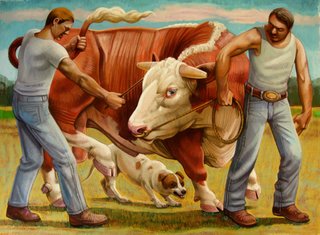
Moving Bull II by Nora Othic
Othic: This is an earlier piece I did called "Bar Room Brawl." I am interested in doing lots of action. You can see the diagonals run in the arms, how they echo each other...These are fun pieces, if nothing else I get lots of reaction. I took them to fairs and I would get people who walk by, go run and get their friend or husband, and say "you gotta see this." (Click on triangle to view video)
Othic: This will be 27 by 37 when I am done.
8 minute video about her compositions in her studio. Click on triangle.
8 minute video about her compositions in her studio. Click on triangle.
Carnies pose for picture. Click on triangle.
Othic had done factory work for 10 years. At age 33, she went to the Missouri University at Columbia to pursue a BFA degree.
Othic: How you make a living as an artist is something you must have plan. I did art fairs pretty much for the last 20 years. That can work for some. I have friends that do a very good living at it, but I never did great at it and then the economy started tightening up about four years ago, I was doing even worse. I tried it and barely made it. So I decided I would push galleries more.....You need to look at who is buying your work. You got to study the demographics. And I found that probably 75 percent of my customer base is either some kind of artist or academic. They don't hit the art fairs a lot. I'm better off doing the galleries.....My husband Johnny is a retired postal worker and his emotional and financial support make it possible for me to work as an artist.
Othic: For 20 years I've been working full time at this....My advice to young budding artists is....do a lot. Draw a lot or paint a lot. Create a lot of work. And look at a lot of work. Those are the two things that will help you grow as an artist. Be nice to people. There is a lot of cut throat competitveness in art. And it is easy to get jealous of people. Just help each other out.
For more information: CONTACT any of the following galleries:
Tom Deatherage at the Late Show, 1600 Cherry Street in Kansas City, Missouri (816) 474-1300
Tom Deatherage at the Late Show, 1600 Cherry Street in Kansas City, Missouri (816) 474-1300
Jennifer Perlow at PS Gallery, 812 East Broadway in Columbia, Missouri (573) 442-4831 info@perlow-stevensgallery.com
Bob Swain at Beauchamp's, 3113 SW Huntoon St in Topeka, Kansas (785) 233-0300 beauchampart@cox.net
North Missouri Art Council at 111 South Main Street USA in Marceline, Missouri info@nomoart.com
Bob Swain at Beauchamp's, 3113 SW Huntoon St in Topeka, Kansas (785) 233-0300 beauchampart@cox.net
North Missouri Art Council at 111 South Main Street USA in Marceline, Missouri info@nomoart.com
Labels: Anthony Van Dyke, Beauchamp's, carrollton, Carrollton Library, Jackson Pollack, Late Show, missouri artist, NOMO, Nora Othic, pastels, PS gallery
